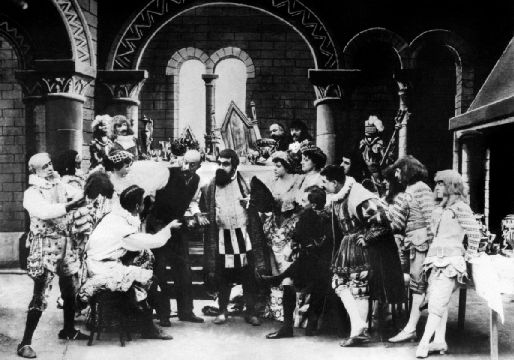Barbe-bleue (1901) 

Director: Georges Méliès
Cast: Georges Méliès, Jeanne d’Alcy, Bleuette Bernon
Synopsis: A young woman becomes the eighth wife of the wealthy Bluebeard, whose first seven wives have died under mysterious circumstances.
While it’s Georges Méliès’ 1902 film La voyage dans la lune that’s widely regarded as his crowning glory, his adaptation of the grisly Charles Perrault fairy tale Bluebeard was by far his most elaborate and successful film up to that point. The production boasted a number of detailed sets which, while no more sophisticated than those you might find at an amateur drama production today, are incredibly advanced for its era. The kitchen set even has stairs leading up to its floor and its ceiling upon which a number of actors ascend, while a banquet hall is intricately drawn to lend a convincing illusion of depth to an otherwise shallow stage. The film also has a large cast, all of whom are fully costumed.
Barbe-Bleue is made up of ten scenes, the first of which shows Bluebeard buying himself a wife from amongst a selection of reluctant potential brides. At least three of them turn their back on the chap, whose reputation for having wives going ‘missing’ obviously precedes him, but when he produces a chest full of treasure, the father of one woman gives her no choice but to marry the old boy. From the actions and body language of the actress playing the unlucky bride-to-be it’s clear to see that she is far from happy about the situation.
After the wedding ceremony and banquet, the couple settle down to married life. The bride has the run of the castle — apart from one room, which, with much pantomime-like waving of his arms, Bluebeard forbids her from entering, even though he leaves her with the key to it. It’s at this point that the familiar Méliès trick photography, which has been absent up to this point, finally kicks in with an imp somehow appearing from within the pages of a large book resting on a lectern as the wife struggles with the temptation of entering the forbidden room. It’s quite possible that this special effect is the best Méliès ever achieved, so seamless is the imp’s appearance. There’s also an angel very similar to the Fairy Godmother who made Cinderella’s wishes come true in 1899’s Cendrillion, who attempts in vain to dissuade the wife from entering the room.
The scene that follows is a remarkably striking and macabre one for such an early movie, with the curious wife blundering around in the darkened room once she finally enters. We can see the bodies of Bluebeard’s former wives hanging in the darkness, but she can’t until she manages to open the shutters that cover the windows. Horrified, she drops the room’s key onto the blood-soaked floor and is subsequently unable to wash off the blood, thus ensuring that her husband will discover her trespass upon his return.
Méliès apparently wrote narration notes to accompany Barbe-bleue, but most of the film is fairly easy to follow, even if you’re unfamiliar with the story. Only the wife’s repeated attempts to wash the key — which looks no different from before it was dropped in the blood — might prove mystifying to newcomers to the tale. Méliès certainly pulls no punches regarding the bloodthirsty tone of the tale, and conjures up some gruesome images, with characters being dragged down stairs and pinned to walls by a sword rammed through their chest. His trick efforts, such as the appearance of that imp, and a dream sequence in which the wife is revisited by her deceased predecessors and a collection of dancing keys, are presented with skill and confidence, and it’s easy to see the huge strides Méliès had made since his earliest efforts.
(Reviewed 27th August 2014)
httpv://www.youtube.com/watch?v=9aj41N5ET5Y
